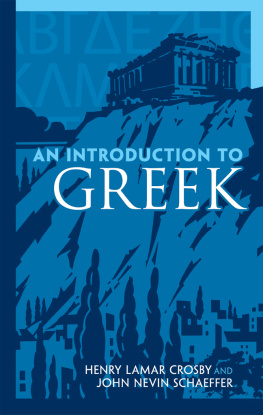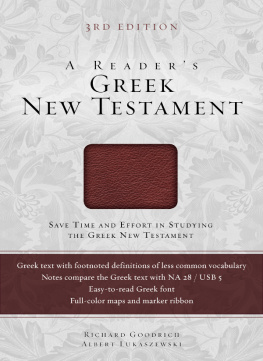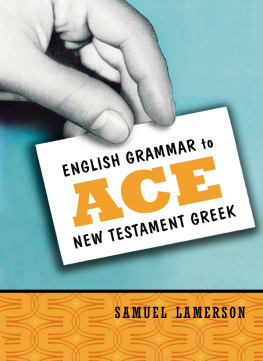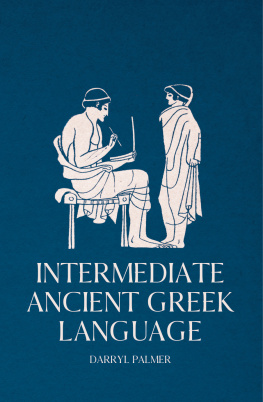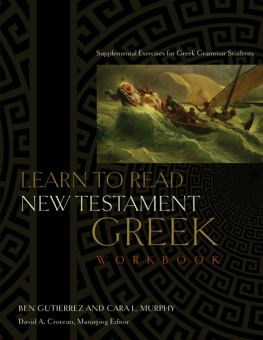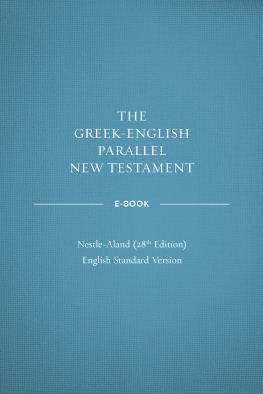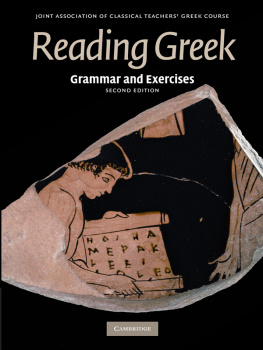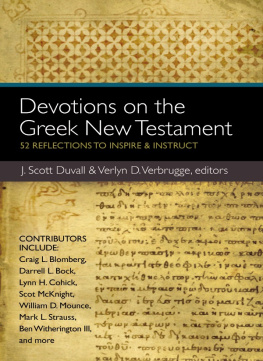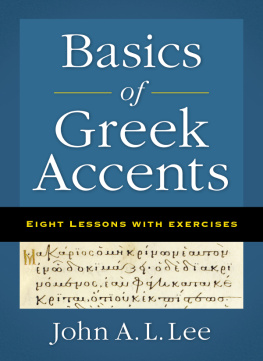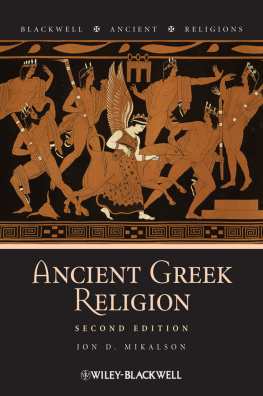
A R EADING FROM H OMER.
AN INTRODUCTION TO
GREEK
HENRY LAMAR CROSBY
AND
JOHN NEVIN SCHAEFFER
DOVER PUBLICATIONS, INC.
MINEOLA, NEW YORK
Bibliographical Note
This Dover edition, first published in 2009, is an unabridged republication of the work originally published by Allyn and Bacon, Boston, in 1928. The original color frontispiece has been reproduced here in black and white. In the present edition, four full-page illustrations have been repositioned, and a map of the Greek peninsula has been omitted for space considerations.
Library of Congress Cataloging-in-Publication Data
Crosby, H. Lamar (Henry Lamar), b. 1880.
An introduction to Greek / Henry Lamar Crosby and John Nevin Schaeffer.
p. cm.
Includes index.
Previously published: Boston : Allyn and Bacon, c1928.
eISBN-13: 978-0-486-12346-2
1.Greek languageGrammar. I. Schaeffer, John Nevin, 1882 II. Title.
PA258.C87 2009
488.2421dc22
2008051076
Manufactured in the United States of America
Dover Publications, Inc., 31 East 2nd Street, Mineola, N.Y. 11501
PEEFACE
THE glory that was Greece means little to a student whose first Greek book presents only grammar. This Introduction to Greek gives him an insight into the brilliant achievements of ancient Greece, and at the same time, in a logical, thorough, and interesting manner, it develops in him the power to read Greek.
Appropriate Greek mottoes at the head of each lesson indicate the universality of Greek thought. Selected passages for translation, with challenging titles, introduce the student to many notable writers and let him see how human and how much alive the ancient Greeks really were. Exercises on derivation and word-formation, together with the derived English words that occur in the lesson vocabularies, show him how vital a part Greek still plays in our English language and thought. Numerous beautiful pictures add to his interest and understanding of Greek achievement and influence.
All the readings are carefully adapted to the growing powers of the student. The vocabulary to be memorized is limited to 600 words, chosen from those most often used in the first four books of Xenophons Anabasis, from those most useful in understanding English terms, and from cognates. All these words, except a few in the last group of lessons, appear at least four times in the exercises.
Special emphasis is given to syntactical constructions of most frequent occurrence in Anabasis, I-IV. To insure greater concentration upon what is vital, certain forms not needed in the early stage of Greek study are relegated to the Appendix. Every point of syntax to be mastered is used at least five times. The rules for the most part are phrased in the order in which the phenomena meet the eye of the reader of Greek and not as instructions for one translating from English into Greek.
Particular attention is called to the sentences for translation into Greek. These deal with the vocabulary, forms, and syntax of the previous lesson. Since students consider the English sentences the hardest and the least possible of improvisation, they often turn to them before finishing the necessary preliminary work. The present plan prevents this and assures adequate preparation.
Systematic reviews have been placed at intervals to follow successive groups of inflections. They have been so handled as to necessitate a rethinking of the matters under review and to prevent mere recitation by rote. Toward the end of the book a number of lessons are in part devoted to a review of case and mood forms and uses, so that the student may properly organize his knowledge into usable form. All through the book an effort has been made to stimulate consecutive thinking as against mere rote memory.
The authors acknowledge their indebtedness to the report of the Classical Investigation, whose findings and recommendations have been of great help, whether they concern Greek or Latin.
Thanks are due also Professor Shirley H. Weber, of Princeton University, and Dr. W. F. Dales, of Washington, D. C, for reading the manuscript of this book and for making valuable suggestions. Acknowledgment is due for permission to quote from the following: F. G. Allinson, Greek Lands and Letters (Houghton Mifflin Co.); John H. Finley, The Prayer of Socrates (The Outlook Co.); T. R. Glover, Herodotus (University of California Press); James Russell Lowell, Address on Books and Libraries (Houghton Mifflin Co.); E. S. McCartney, Warfare by Land and Sea (Longmans, Green and Co.); H. G. Wells, Tono-Bungay (Duffield and Co.); A. F. West, Value of the Classics (Princeton University Press). The authors wish also to thank for the generous loan of photographs : Dr. Carl W. Blegen, of the University of Cincinnati; Dr. A. C. Schlesinger, of Williams College; Dr. R. S. Rogers, of Princeton University; Dr. Clarence Kennedy, of Smith College; and Mr. George R. Swain, of the University of Michigan.
H ENRY L AMAR C ROSBY
Professor of Greek, and
Dean of the Graduate School
University of Pennsylvania
J OHN N EVIN S CHAEFFER
Professor of Greek
Franklin and Marshall College

T HE S OUTH C OLONNADE OF THE P ARTHENON
No mortar was used in Greek temples, but the joints in these columns are scarcely visible. (For a picture of the Parthenon, see .)
CONTENTS
READING SELECTIONS
| By Their Fruits | S T. L UKE |
| Marathon | H ERODOTUS |
| Some Axioms | E UCLID |
| In the Beginning | S T. J OHN |
| An Ancient Paradox | M ENANDER |
| More Axioms | E UCLID |
| In Hostile Territory | X ENOPHON |
| A Traitor Caught | X ENOPHON |
| The Review of an Army | X ENOPHON |
| Human Frailty | S T. J AMES |
| A Heavy Snowfall | X ENOPHON |
| A Wise Camel | A ESOP |
| Dramatis Personae | X ENOPHON |
 | H ERODOTUS |
| Time the Healer | M ENANDER |
| The Keynote of Greek Genius | P LATO |
| The Better Part of Valor | A ESOP |
| Philosopher and Friend | X ENOPHON |
| Loose Logic | A NACREONTIC |
| Q. E. D | D IOGENES LAERTIUS |
| Peace and War | M ENANDER |
| Strange Doctrine for a Pagan | P LATO |
| A Traitor Caught (Continued) | X ENOPHON |
| They That Go Down to the Sea in Ships | S OPHOCLES
M ENANDER |
| What Fools These Mortals Be | A ESOP |
| The Delphic Oracle | X ENOPHON |
| On Mars Hill | S T. PAUL |
| A Practical Politician | P LUTARCH |
| Eros Wins | A NACREONTIC |
| Wisest of All | A NCIENT ORACLE |
| Aristotle on Friendship | D IOGENES LAERTIUS |
| Esse Quam Videri | A ESCHYLUS |
| Optimism | E URIPIDES |
| Maxims | M ENANDER |
Next page
